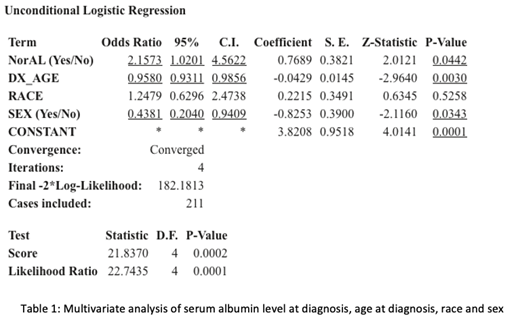Abstract
Introduction: The role of serum albumin as a prognostic factor has been well established in various medical conditions including some hematologic malignancies such as multiple myeloma and myelodysplastic syndromes . In this retrospective analysis, we examined the prognostic value of serum albumin at diagnosis prior to any therapy in a cohort of patients with acute myeloid leukemia (AML) irrespective of treatment modality.
Methods: Data were collected retrospectively in a cohort of 257 AML patients who received treatment between 2002 to 2019. The cohort included patients who received conventional 7+3 induction, patients who were not candidates for induction receiving lower intensity chemotherapy +/- targeted drug, and patients who were placed on clinical trials. Patients under the age of 17 were excluded, as well as patients who received their initial diagnosis and induction at an outside hospital whose initial laboratory data for albumin were not available. We excluded patients who were not identified as Caucasian or African American in our final analysis. 46 patients were lost to follow up before 6-months and were excluded from all analysis. Analysis were performed with Epi Info software. Our patients were dichotomized by serum albumin ≥3.5 (normal albumin) and <3.5 (hypoalbuminemia [HA]). Chi-square test was performed for univariate analysis of categorical variables and logistic regression was performed for multivariable analysis.
Results: Of the 211 patients, the median age was 59.4 years (17 - 83.4) with 1:1 male to female ratio. 171 patients survived to 6 months and were included in our analysis. There was no significant age difference between normal albumin and HA groups (median age 59 and 59.7 respectively, p=0.854). There was an equal distribution of patients with HA with respect to sex (33.0% male and 36.9% female, p=0.560). With regards to race, more African Americans were found to have hypoalbuminemia compared to Caucasians (46% African Americans vs. 30% Caucasians, p=0.027). Patients with HA had an overall survival rate of 72.2% at 6 months while those with normal albumin levels had a survival rate of 85.1% (p=0.027). Multivariate logistic regression analysis including age, race, sex and albumin levels showed that age, sex and albumin levels were statistically significant independent predictors of survival at 6 months [Table 1]. Patients with albumin ≥3.5 were significantly more likely to survive controlling for age, race, and sex (OR=2.16, p=0.044). Multivariate analysis additionally showed that age was inversely associated with survival at 6-months (p=0.003) and males were more likely to survive than females (p=0.034). Though African Americans were shown to have a higher incidence of HA in univariate analysis, race was not an independent predictor for survival in the multivariate analysis when controlling for age, sex, and albumin level.
Conclusions: In this cohort of AML patients, we found that hypoalbuminemia is an independent predictor survival. Serum albumin <3.5 was associated with a significantly decreased overall survival at 6-months. Age and sex were additional independent predictors of 6-month survival. This data suggests that hypoalbuminemia, defined as albumin <3.5, has prognostic utility in AML patients.
No relevant conflicts of interest to declare.


